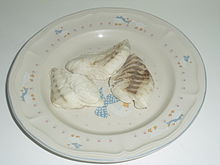Painted sweetlips
Appearance
| Painted sweetlips | |
|---|---|

| |
| Scientific classification | |
| Domain: | Eukaryota |
| Kingdom: | Animalia |
| Phylum: | Chordata |
| Class: | Actinopterygii |
| Order: | Perciformes |
| Family: | Haemulidae |
| Genus: | Diagramma |
| Species: | D. pictum
|
| Binomial name | |
| Diagramma pictum (Thunberg, 1792)
| |
| Synonyms[1] | |
| |

The painted sweetlips or slate sweetlips, Diagramma pictum, is a species of marine fish in the family Haemulidae.[2] It is widespread throughout the tropical waters of the Indo-West Pacific region, Red Sea included.[3] This species reaches a length of 100 cm (39 in), but common size is 55 cm (22 in).[4]
As other fish, the painted sweetlips is the host of many parasites. These include the lepocreadiid digenean Holorchis castex and the monorchiid digenean Lasiotocus plectorhynchi in the intestine[5] and the cystidicolid nematode Metabronemoides mirabilis in the stomach.[6]
References
- ^ Nicolas Bailly (2015). "Diagramma pictum (Thunberg, 1792)". World Register of Marine Species. Retrieved 22 July 2017.
- ^ http://www.fishbase.org/comnames/CommonNamesList.php?ID=4465&GenusName=Diagramma&SpeciesName=pictum&StockCode=4662
- ^ http://www.fishbase.org/summary/60078
- ^ http://www.fishbase.org/summary/4465
- ^ Bray, R. A. & Justine, J.-L. 2007: Holorchis castex n. sp. (Digenea: Lepocreadiidae) from the painted sweet-lips Diagramma pictum (Thunberg, 1792) (Perciformes: Haemulidae) from New Caledonia. Zootaxa, 1426, 51-56.
- ^ Moravec, F. E.; Justine, J. L. (2010). "Two new genera and species of cystidicolids (Nematoda, Cystidicolidae) from marine fishes off New Caledonia". Parasitology International. 59 (2): 198–205. doi:10.1016/j.parint.2010.01.005. PMID 20129064.
External links
- http://www.marinespecies.org/aphia.php?p=taxdetails&id=218536
- http://australianmuseum.net.au/Painted-Sweetlips-Diagramma-pictum-Thunberg-1792/
- Photos of Painted sweetlips on Sealife Collection
